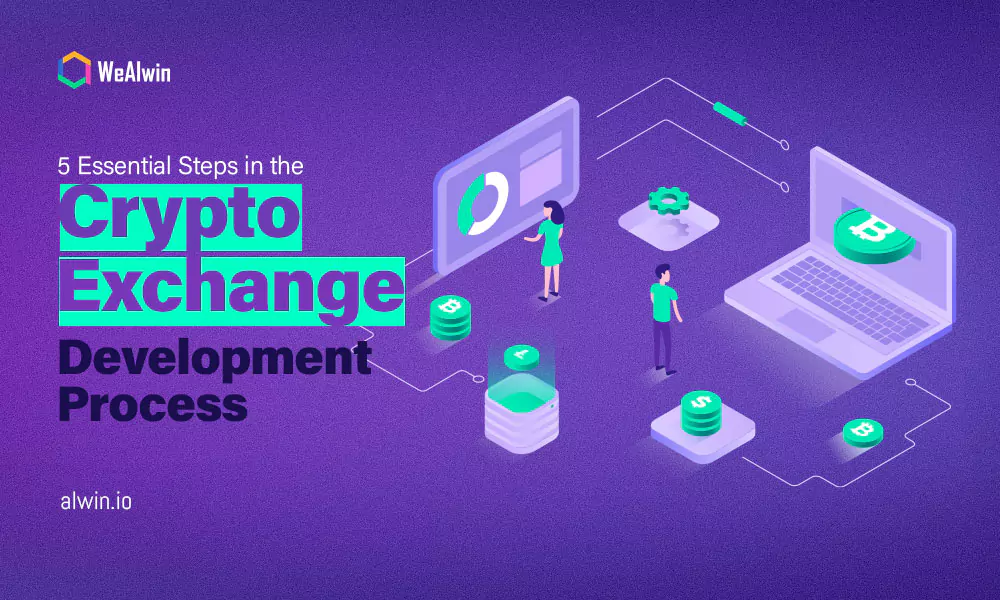
Swiftly accessing internet data and making latency-free trading decisions in the highly volatile market to maximise profitability poses a complex challenge. This is where crypto exchange APIs come into play, serving as crucial tools in this endeavour. These APIs, provided by exchanges, offer the means to access data, functions, and automation, fundamentally reshaping your trading strategy.
Ignite the possibility of Crypto Exchange APIs for real-time data, swift trades, efficient portfolio management, and precise trading strategies. Whether you're an experienced trader or new to algorithmic trading, expertise in the use of these APIs is essential.
Our blog post guides you through setting up API keys, securing connections, using automated trading algorithms, and staying informed about market trends. This comprehensive guide covers everything you need to efficiently utilize these APIs for successful trading.
Crypto Exchange APIs: A Complete Introduction
What are Crypto Exchange APIs?
Crypto exchange APIs let you engage with crypto exchanges programmatically. They empower you to access real-time market data, execute trades, and manage accounts without the need for manual intervention. These APIs give you the ability to tap into live market data, exchange rates, and historical data, and perform various functions such as placing trades and retrieving asset details through endpoints.
The Role of APIs in Cryptocurrency Trading
APIs act as bridges allowing your trading software to communicate directly with exchange servers. This automation opens up countless opportunities for efficiency and optimization in your trading strategy.
Advantages and Disadvantages of API Trading
| Advantages |
Disadvantages |
|
Emotional Elimination: With API trading, emotions are taken out of the equation, promoting discipline and adherence to a predetermined strategy.
Swift Order Entry: APIs facilitate faster order execution, a necessary factor in volatile markets where timing is everything.
Backtesting Capability: Traders can assess the viability of their strategies by testing them on historical data, and refining trading rules in the process.
Efficient Diversification: APIs empower traders to efficiently diversify their portfolios across multiple markets.
|
Technical Complexity: Setting up and managing API trading demands technical proficiency.
Regulatory Considerations: Depending on the jurisdiction, there may be legal implications when using automated trading systems.
Absence of Human Intuition: Automated trading lacks the human touch, which can be valuable in specific market conditions.
|
Types of APIs Available in the Market
There's a variety to choose from, and we have four main types of APIs that developers commonly use. Each type has its own unique purposes, catering to different audiences and usage scenarios.
1. Public APIs
These are also known as open or external APIs, and they're available to any developer or user with minimal restrictions. To access these APIs, you might need to register, use an API key, or employ OAuth. Public APIs are all about external users accessing data or services without the need for extensive identity verification or use case scrutiny.
2. Partner APIs
Partner APIs are selectively exposed to strategic business partners, requiring specific entitlements for access. They make communication beyond the company smoother and foster innovation without the hassle of rewriting existing code.
3. Internal APIs
These are crafted for use within an enterprise, connecting systems and data internally. Internal APIs are the backbone for linking various systems within a business, like tying together payroll and HR systems.
4. Composite APIs
Composite APIs take it up a notch by combining multiple APIs to create a unified interface capable of interacting with various services simultaneously. They are incredibly useful for integrating complex systems and applications, and aggregating functionalities from different sources.
Custom APIs vs. Standard APIs
| |
Custom APIs |
Standard APIs |
| Ease of use |
May require more effort to set up and integrate |
Pre-existing and easy to implement |
| Flexibility |
Tailored to specific needs |
Limited to predefined functionalities |
| Development time |
Can be time-consuming and expensive to develop |
Quick to implement |
| Cost |
Can be costly to maintain and update |
Often free or low-cost |
| Maintenance |
Requires ongoing maintenance and updates |
Generally low maintenance |
Setting Up Your Trading Environment
Let's set up your account on a crypto exchange
Choose your exchange wisely, taking into account security, fees, available trading pairs, user interface, customer support, and reputation.
Register on your chosen exchange: provide your email, create a secure password, and complete any necessary verification steps.
In our case, we take Binance as an example
To create your own Binance API Key, follow these steps:
1. Log in to your Binance account and click on [Profile] - [API Management].

Now, let's generate some API keys
API keys are vital for using the exchange's API, consisting of a public key (for identification) and a private key (for authentication).
Follow the exchange's guidelines to generate API keys securely. Usually, login, go to API settings, and create a new set of keys.
2. Click on [Create API].

3. Select your preferred API Key type - system-generated keys use HMAC symmetric encryption, while self-generated keys use Ed25519 or RSA asymmetric encryption.

4. Enter a label/name for your API Key.

Secure your account: enable two-factor authentication (2FA), use a robust password, and be cautious of phishing attempts.
5. Verify your request with 2FA devices and passkeys.

6. Your API key is now created
Keep your API keys safe and avoid sharing them. Treat it as sensitive information to prevent unauthorized access.
Understanding API Rate Limits is key
API rate limits determine how many requests you can make within a specific timeframe. Going over these limits can lead to temporary restrictions or bans.

Check the exchange's API documentation to grasp their rate limit policies. This knowledge helps optimize your trading and avoid disruptions.
Implement strategies like batching requests, prioritizing crucial actions, and monitoring your usage to stay within the allowed limits.
Essential Tools and Software
If you're looking to pick the right trading platforms and tools for API trading, check out some of the best brokers with API access in 2024.
These brokers give you access to API trading platforms that make execution quicker, improve connections to live market data, and allow you to generate reports about your orders and trades.
Here are some of the best API trading platforms
- Pepperstone – The top Forex API Broker
- AvaTrade API – The best Stock Broker with API & No Commission
- IG API – One of the best brokers with API access & a demo account
- XTB API – Among the top trading platforms with API & no minimum deposit
- Saxo Capital Markets – Top FX Trading API Brokerage
- Coinrule – API Trading Platform with a user-friendly interface
- Interactive Brokers API - Dealer with the best Stock API Access
- Robinhood API - Dealer with the best Stock API Access
Developing a Trading Strategy
When you're crafting a trading strategy, make sure to establish clear and achievable goals that focus on the process rather than just the results.

New traders, focus on goals tied to their trading processes, mirroring professional traders. Prioritize a well-thought-out plan, knowing when not to trade, and keeping your strategy simple.
For financial market success, set realistic goals considering your capabilities, capital, timeframe, and motivation. Unrealistic goals lead to dissatisfaction, emotional trading, poor performance, and tracking difficulties. Choose goals based on your style, time horizon, and financial objectives.
A strong trading plan includes defining objectives, aligning with a suitable style, crafting a detailed strategy, setting realistic return expectations, conducting thorough market analysis, and implementing effective risk management.
Analyzing Market Trends
Traders can analyze market trends using technical indicators like moving averages, relative strength indexes, and stochastic oscillators to develop a trading strategy.
Objective rules for taking action, including trade filters and triggers based on indicators, form a crucial part of these strategies.
There are different types of technical analysis strategies, such as trend-following, mean-reversion, momentum, breakout, and chart patterns.
Another approach, known as price action trading, focuses on price movements rather than technical indicators. This allows traders to make subjective decisions based on recent price history.
Various technical analysis strategies encompass trendline strategies, Ichimoku Cloud strategies, moving average crossover strategies, time-weighted average price (TWAP) strategies, seasonality strategies, and event-driven strategies like analyst estimates and insider trading activity.
Additionally, volume strategies like volume profile and relative volume (RVOL), as well as other approaches like price action trading, contribute to the trader's toolkit.
These strategies, informed by either technical or fundamental analysis, aim to generate profitable returns by identifying trading opportunities and managing risks effectively.
Risk Management in API Trading
To minimize risks and maximize returns in API trading, you need to actively implement effective risk management strategies.
Here are some key tips based on the search results
Use Stop-loss Orders: Set predetermined levels to automatically close positions and limit potential losses.
Employ Trailing Stop Orders: Similar to stop-loss orders but with a dynamic stop level that trails the market price at a certain distance.
Monitor Market Volatility: Access real-time market data to effectively keep an eye on volatility levels and adjust position sizes accordingly.
Diversify Your Portfolio: Spread your capital across different currency pairs and strategies to reduce the impact of potential losses on your overall portfolio.
Implement Risk Assessment Algorithms: Utilize advanced algorithms to analyze market data, historical trends, and risk factors for real-time risk assessment.
Backtest and Simulate Strategies: Evaluate the performance of your strategies using historical market data to refine them and identify potential risks.
Mastering API Trading Operations in 8 Steps

Step 1: Connect to a Trading Platform
Initiate your first trade using an API by connecting to a trading platform, programmatically submitting trade requests, and understanding response mechanisms.
Step 2: Automate Buy or Sell Orders
Define parameters like price, quantity, and timing to automate buy or sell orders based on predetermined criteria, ensuring efficient decision-making and timely execution.
Step 3: Understand Order Types
Differentiate between market orders, limit orders, and stop orders. Market orders execute at the current market price, limit orders allow specifying prices, and stop orders trigger market orders at predefined price levels.
Step 4: Execute and Manage Orders
Efficiently manage orders by monitoring trade executions, adjusting strategies based on market conditions, and utilizing order management tools for optimal results. Ensure timely and accurate execution of trading decisions.
Step 5: Explore Advanced Trading Techniques
Implement algorithmic trading strategies using predefined rules, leverage webhooks for real-time reactions to market events, and utilize stop loss and take profit features to protect investments.
Step 6: Utilize Real-Time Monitoring Tools
Employ tools for real-time monitoring to stay updated on market trends, trade performance, and portfolio management. Gain insights for informed decision-making and prompt strategy adjustments.
Step 7: Analyze Trade Performance
Reflect on past trades, identify strengths and weaknesses in trading strategies, and learn from both successful and unsuccessful trades. Analyze performance metrics to refine your approach for better outcomes.
Step 8: Adapt Strategies to Market Changes
Stay informed about economic indicators, news events, and technical analysis. Adapt your trading strategies flexibly based on evolving market conditions to maintain competitiveness and seize opportunities.
Overcoming Common Challenges in API Trading
To tackle the common hurdles faced in API trading, you need to actively address various aspects.
Dealing with API Limitations
It's imperative to grasp and manoeuvre through rate limits effectively. Understanding these constraints is essential to operating within them seamlessly.
Overcoming Latency Issues
The key to success in API trading lies in minimizing latency. Every second counts, so reducing delays is vital for a smooth trading experience.
Handling API Downtime and Outages
It's not a matter of if, but when things don't go as planned. Having a well-thought-out plan in place for API downtime and outages is essential to navigating through unexpected disruptions.
Security Considerations
Prioritize best practices for API key security. Avoiding common security pitfalls and having robust response strategies in place for potential security breaches are paramount for a secure trading environment.
Troubleshooting and Support
Identifying common API issues is the first step. Utilize exchange support and documentation, and tap into community resources and forums for additional support. These resources can prove invaluable when troubleshooting problems.
In essence, by understanding and actively addressing these challenges, traders can effectively navigate the complexities of live algo trading.
Top Cryptocurrency Exchange APIs of 2024
- Token Metrics Crypto API
- Binance API
- Coinbase API
- Kraken API
- Bitfinex API
- Huobi API
- Bitstamp API
- KuCoin API
Future Trends in Crypto Exchange API Trading
Cryptocurrency APIs are at the forefront of this revolution, transforming the trading landscape with their real-time data access, user-friendliness, and reliability.
These APIs simplify our access to live data streams, empowering traders to make informed decisions swiftly, based on timely and accurate market insights.
Blockchain Innovations and Cryptocurrency APIs: Cryptocurrency APIs are the rockstars of the digital finance realm. They've done a total makeover by serving up real-time market data and opening up a world of opportunities for developers. It's like they took the complex jargon of finance and turned it into an easy-to-digest stream of information. Talk about simplifying the game!
Artificial Intelligence in Trading: Now, let's talk about Artificial Intelligence (AI) taking the reins in crypto trading. It's not just a sidekick; it's the superhero! AI is doing some serious magic by bringing in advanced tools for automation and kicking trading strategies up a notch. It's like having a tech-savvy ally in the crypto trading world – making moves, crunching numbers, and refining strategies like a pro.
Secure Trading Protocols: Security is the VIP in the crypto world, and advancements in secure trading protocols are the real MVPs. These protocols are like the guardians of the crypto realm, putting encryption techniques, secure authentication mechanisms, and top-notch compliance with regulatory requirements like AML and KYC at the forefront. Because when it comes to crypto, safety always comes first!
The global crypto APIs market is projected to experience substantial growth, with a Compound Annual Growth Rate (CAGR) of 22.8% from 2023 to 2033. By 2033, the market value is expected to reach an impressive US$ 5,569.6 million.
Regulatory Landscape for API Trading
Navigating the regulatory landscape for API trading is crucial for businesses to ensure both compliance and operational success. Let's delve into key insights gathered from the search results
Licensing & US Fintech Regulations
The U.S. fintech industry is undergoing rapid evolution, making it imperative for businesses to have a solid grasp of regulatory requirements. This understanding is vital not only for ensuring operational compliance but also for paving the way for overall business success.
API Algo Trading Landscape
Algorithmic trading tools take center stage in API trading, playing a pivotal role in providing a diverse set of functionalities. These tools range from idea generation to facilitating live trading on API brokers, underscoring their significance in the dynamic landscape of API trading.
Key Regulatory Challenges in API Manufacturing
API manufacturers encounter a spectrum of evolving regulatory challenges. These challenges revolve around meeting Good Manufacturing Practice (GMP) requirements, navigating FDA inspections, making prudent vendor selections, and staying competitive in the market. Understanding and effectively addressing these challenges are crucial for success in API manufacturing.
API Compliance
Maintaining API compliance is a cornerstone in the financial services landscape. It is not only essential for securing sensitive data but also for preventing breaches and adhering to specific regulations governing API development and usage. Prioritizing API compliance ensures a robust and secure foundation for financial operations.
Transformation of Commercial Cards with APIs
APIs are poised to revolutionize commercial cards by fostering enhanced connectivity, improving operational efficiency, and addressing regulatory challenges. This transformation will be achieved through the utilization of private, partner, and open APIs, promising a significant impact on the commercial card landscape.
Predictions for the Future of API Trading
Get ready for the future of API trading!
In the next year, expect the APIS (API) to fluctuate between $0.000148 and $0.000697, with a predicted -7.28% drop to $0.000137 by January 13, 2024.
Agora, Inc. (API) stock is projected to hit $2.71 per share by March 10, 2024, with a Bearish sentiment and a Fear & Greed Index at 39 (Fear).
Hold on tight as the API market is set to skyrocket into multimillion-dollar territory by 2029, fueled by unexpected compound annual growth from 2022 to 2029.
The demand from large enterprises and SMEs, especially in cloud-based and Web-based APIs, will be the driving force.
Innovative trading strategies are on the horizon for APi Group Corporation, with a forecasted 52.1% growth in earnings and a 4.4% boost in revenue per annum.
The company's return on equity is expected to hit 15.7% in the next three years. Based on historical data, APi Group stock has shown an average rise of 26.9% over the next 52 weeks. Get ready for an exciting journey in the dynamic world of API trading!
Conclusion
Navigating the world of crypto exchange APIs might seem difficult at first, but with the right approach, they can become powerful tools in your cryptocurrency trading. Remember, the goal is to understand, efficiently use, and secure your API interactions to make the most of your trading activities. As we look towards the future, staying adaptable and informed will be key to navigating the exciting shifts in the landscape of API trading.
FAQs
What are the first steps to getting started with crypto exchange APIs?
Start by choosing an exchange, registering for an account, and then generating and securely storing your API keys.
How can I ensure my API keys are secure?
Use strong encryption, never share your keys, and consider using dedicated security tools.
What are the common mistakes to avoid in API trading?
Avoid ignoring rate limits, neglecting security practices, and not having a clear trading strategy.
How do changes in regulations affect API trading?
Regulatory changes can impact the features available through APIs as well as your compliance obligations.
Can I use multiple exchange APIs at the same time, and how?
Yes, by using software designed to manage multiple API keys and by employing a strategy that leverages the strengths of each exchange.


















